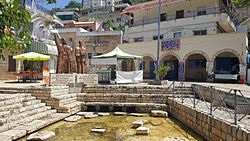
Back البقيعة Arabic البقيعه (قضاء عكا الفرعى) ARZ Buqei‘a CEB Peki'in Czech Pek’in German Peqi'in Spanish Peki'in Finnish פקיעין HE Peki'in Dutch Peki'in NN
You can help expand this article with text translated from the corresponding article in Hebrew. Click [show] for important translation instructions.
|
Peki'in
| |
|---|---|
| Hebrew transcription(s) | |
| • ISO 259 | Pqiˁin |
| • Also spelled | Peqi'in (official) |
 | |
| Coordinates: 32°58′27″N 35°19′53″E / 32.97417°N 35.33139°E | |
| Grid position | 181/264 PAL |
| Country | |
| District | Northern |
| Founded | 5000 BCE (Earliest settlement) |
| Area | |
• Total | 3,565 dunams (3.565 km2 or 1.376 sq mi) |
| Population (2022)[1] | |
• Total | 6,104 |
| • Density | 1,700/km2 (4,400/sq mi) |
| Ethnicity | |
| • Arabs | 99.98% |
| • Jews and others | 0.02% |
| Name meaning | The little valley (between mountains)[2] |
Peki'in (alternatively Peqi'in) (Hebrew: פְּקִיעִין) or Buqei'a (Arabic: البقيعة), is a Druze–Arab town with local council status in Israel's Northern District. It is located eight kilometres east of Ma'alot-Tarshiha in the Upper Galilee. In 2022 it had a population of 6,104.[1] The majority of residents are Druze (78%), with a large Christian (20.8%) and Muslim (1.2%) minorities.[3]
The Jewish community of Peki'in maintained a presence since at least the 16th century with a short interruption during the 1936–1939 Arab revolt.[4] Most Jews in Peki'in did not return to the village after the violence, and call themselves the Hadera [city] Diaspora. The Zinatis are the only family who returned, and it is currently represented by one elderly member, Margalit Zinati, residing in the village.[5][6]
- ^ a b c "Regional Statistics". Israel Central Bureau of Statistics. Retrieved 21 March 2024.
- ^ Palmer, 1881, p. 70
- ^ Peki'in 2019 (in Hebrew)
- ^ Cite error: The named reference
:0was invoked but never defined (see the help page). - ^ Researchers race to document vanishing Jewish heritage of Galilee Druze village, Eli Ashkenaz, 25 July 2012, Haaretz, "Zinati, who was born in 1931, is the last link in the chain of a Jewish community that apparently maintained a continuous presence in Peki'in since the time of the Second Temple, when three families from the ranks of the kohenim, the priestly caste that served in the Temple, moved there. Since then, the only known break in the Jewish presence was during two years in the late 1930s, when the town's Jews fled the Arab riots of 1936–39. Most of them went to what they called the Hadera diaspora. But one family, Zinati's, returned home in 1940."
- ^ Jews and Muslims in the Arab World: Haunted by Pasts Real and Imagined, Jacob Lassner, Rowman & Littlefield, 2007, p.314, "...the small community of Peki'in in the mountains of the Galilee, not far from Safed, whose present-day residents could demonstrate that they were direct descendants of inhabitants of the village who had never gone into exile."

